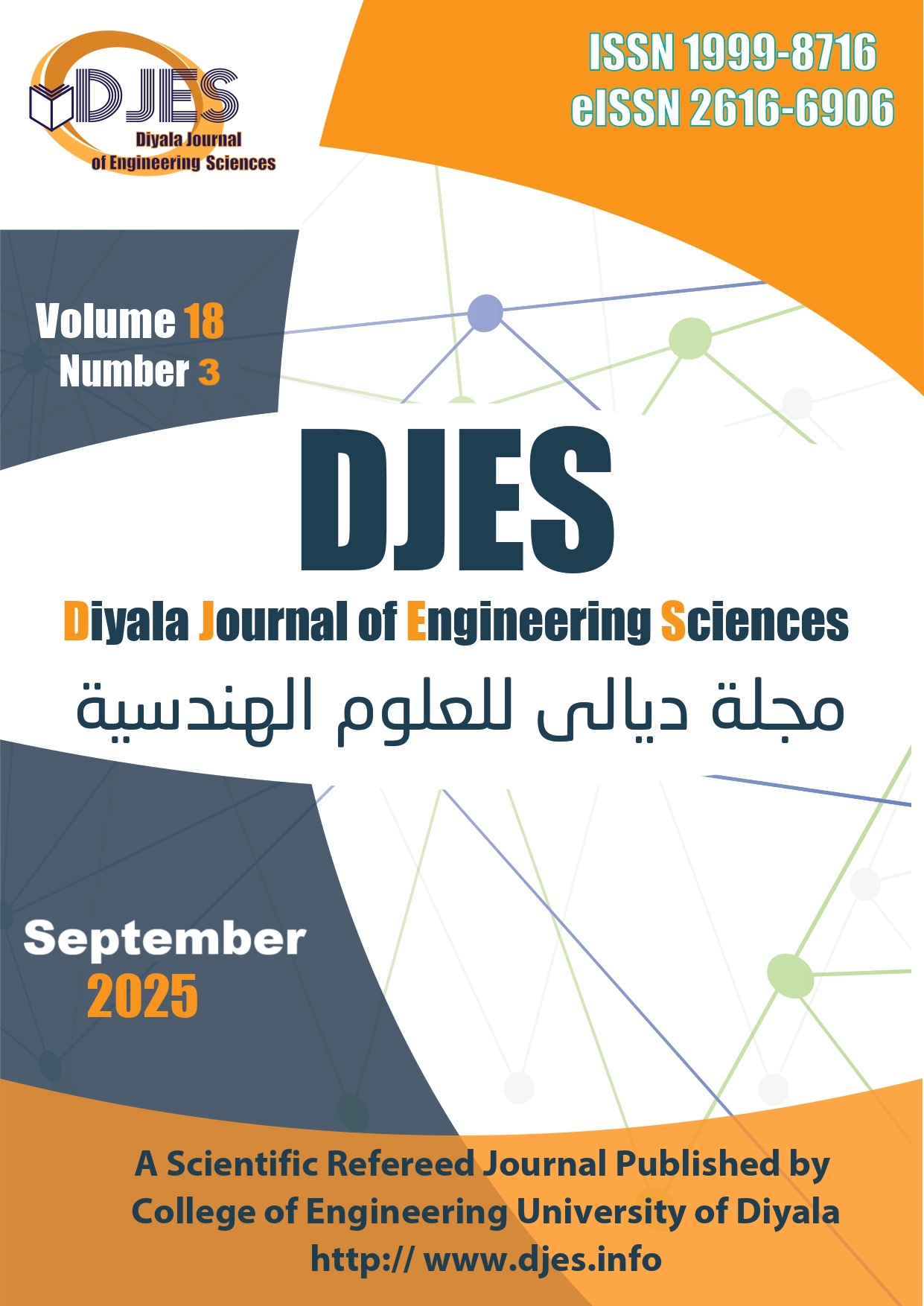Performance Analysis of Solar Air Heaters with Dimpled Roughness in Equilateral Triangular Ducts
DOI:
https://doi.org/10.24237/djes.2025.18313Keywords:
Solar air heater, Dimple-shaped, Performance enhancement criteria, Artificial roughness, Triangular duct.Abstract
Solar air heaters (SAHs) offer a practical and environmentally friendly method of harnessing solar energy. Enhancing the thermal performance of SAHs is critical, and various techniques, including surface modifications, have been explored. This experimental study investigates the influence of dimpled rib roughness on the thermal and hydraulic performance of a SAH with an equilateral triangular duct. The experiments were conducted over a range of operating conditions: relative roughness height (e/D) from 0.023 to 0.058, relative roughness pitch (L/e) from 3 to 9, relative roughness width (S/e) from 6 to 18, and Reynolds numbers from 6000 to 18000. The results indicate that the dimpled rib configuration significantly enhances heat transfer compared to smooth SAH. The maximum enhancement in the Nusselt number (Nu) and friction factor (f) is 5.78 and 2.26 times higher, respectively, than the smooth SAH. The highest performance enhancement criteria (PEC) value of 4.64 is achieved at e/D=0.058, L/e=3, and S/e=6. Additionally, empirical correlations for Nu and f were derived based on experimental data, providing valuable tools for SAH design optimization. This study demonstrates the potential of dimpled ribs to significantly improve SAH performance, making it a viable option for efficient solar energy utilization.
Downloads
References
[1] M. A. Alfellag, H. E. Ahmed, M. G. Jehad, and A. A. Farhan, “The hydrothermal performance enhancement techniques of corrugated channels: a review,” J Therm Anal Calorim, vol. 147, no. 19, pp. 10177–10206, Oct. 2022, doi: 10.1007/s10973-022-11247-1.
[2] A. M. Kadhim and I. M. Ali, “Experimental Evaluation of Evaporative Cooling for Enhancing Photovoltaic Panels Efficiency Using Underground Water,” Journal of Engineering, vol. 26, no. 8, pp. 14–33, 2020, doi: 10.31026/j.eng.2020.08.02.
[3] A. Bhushan, R. Kumar, and A. Perwez, “Experimental investigations of thermal performance for flat and dimpled plate solar air heater under turbulent flow conditions,” Solar Energy, vol. 231, no. November 2021, pp. 664–683, 2022, doi: 10.1016/j.solener.2021.11.060.
[4] S. Panda and R. Kumar, “Investigation of the effect of dimensional and non-dimensional parameters on the performance of pitch-varied staggered arranged dimple solar air heaters,” Solar Energy, vol. 276, no. May, p. 112663, 2024, doi: 10.1016/j.solener.2024.112663.
[5] P. K. Mahto, P. P. Das, S. Diyaley, and B. Kundu, “Parametric optimization of solar air heaters with dimples on absorber plates using metaheuristic approaches,” Appl Therm Eng, vol. 242, no. January, p. 122537, 2024, doi: 10.1016/j.applthermaleng.2024.122537.
[6] A. S. Yadav, S. Gupta, A. Agrawal, R. Saxena, N. Agrawal, and S. Nashine, “Performance enhancement of solar air heater by attaching artificial rib roughness on the absorber Plate,” Mater Today Proc, May 2022, doi: 10.1016/J.MATPR.2022.05.064.
[7] M. M. Mahdi and A. A. Gaddoa, “Outdoor Testing of a Zig-Zag SolarAir heater with and without Artificial Roughness on Absorber Plate,” Journal of Engineering, vol. 25, no. 4, pp. 1–17, 2019, doi: 10.31026/j.eng.2019.04.01.
[8] Y. F. Midhat and I. M. A. Aljubury, “Numerical Simulation of the Thermal Performance of a Tubular Solar Air Heater,” Journal of Engineering, vol. 29, no. 11, pp. 143–166, 2023, doi: 10.31026/j.eng.2023.11.09.
[9] G. Tanda, “Performance of solar air heater ducts with different types of ribs on the absorber plate,” Energy, vol. 36, no. 11, pp. 6651–6660, 2011, doi: https://doi.org/10.1016/j.energy.2011.08.043.
[10 M. A. Karim and M. N. A. Hawlader, “Performance investigation of flat plate , v-corrugated and finned air collectors,” Energy, vol. 31, pp. 452–470, 2006, doi: 10.1016/j.energy.2005.03.007.
[11 A. A. Farhan, I. M. A. Aljubury, and H. E. Ahmed, “Energetic and exergetic efficiency analysis of a v-corrugated solar air heater integrated with twisted tape inserts,” Renew Energy, vol. 169, pp. 1373–1385, 2021, doi: 10.1016/j.renene.2021.01.109.
[12 M. Yang, X. Yang, X. Li, Z. Wang, and P. Wang, “Design and optimization of a solar air heater with offset strip fin absorber plate,” Appl Energy, vol. 113, pp. 1349–1362, 2014, doi: 10.1016/j.apenergy.2013.08.091.
[13 A. Kumar and M. H. Kim, “Numerical optimization of solar air heaters having different types of roughness shapes on the heated plate - Technical note,” Energy, vol. 72, pp. 731–738, 2014, doi: 10.1016/j.energy.2014.05.100.
[14 M. Alaskari, A. M. Kadhim, A. A. Farhan, M. Al-Damook, and M. Al Qubeissi, “Performance Evaluation of Roughened Solar Air Heaters for Stretched Parameters,” Clean Technologies, vol. 4, no. 2, pp. 555–569, 2022, doi: 10.3390/cleantechnol4020034.
[15] A. K. Hegde, R. Pai, and K. V. Karanth, “Influence of solar insolation on energy and exergy efficiency of a rectangular duct solar air heater with various types of V rib roughness: An analytical approach,” International Communications in Heat and Mass Transfer, vol. 153, Apr. 2024, doi: 10.1016/j.icheatmasstransfer.2024.107397.
[16] A. A. Farhan, H. E. Ahmed, and M. A. Mussa, “Thermal–Hydraulic Performance of a V-Groove Solar Air Collector with Transverse Wedge-Shaped Ribs,” Arab J Sci Eng, vol. 47, no. 7, pp. 8915–8930, 2022, doi: 10.1007/s13369-021-06442-5.
[17] T. Alam, “Development of correlations of Nusselt number and friction factor of solar thermal collector equipped with hybrid rib roughness,” Solar Energy Materials and Solar Cells, vol. 272, Aug. 2024, doi: 10.1016/j.solmat.2024.112887.
[18] C. Mund, S. Kumar Rathore, and R. Kumar Sahoo, “Experimental investigation of heat transfer augmentation of impinging jet solar air heater with stepped transverse ribs,” Thermal Science and Engineering Progress, vol. 56, p. 103020, Dec. 2024, doi: 10.1016/j.tsep.2024.103020.
[19] B. Markam and S. Maiti, “Artificial enhancer for small-scale solar air heater—A comprehensive review,” Cleaner Energy Systems, vol. 4, no. November 2022, p. 100046, 2023, doi: 10.1016/j.cles.2022.100046.
[20] H. K. Moon, T. O. O’Connell, and B. Glezer, “Channel height effect on heat transfer and friction in a dimpled passage,” Transactions of ASME Journal of Gas Turbine and Power, vol. 122, no. 2, pp. 307–313, 2000.
[21] R. P. Saini and J. Verma, “Heat transfer and friction factor correlations for a duct having dimple-shape artificial roughness for solar air heaters,” Energy, vol. 33, no. 8, pp. 1277–1287, 2008, doi: 10.1016/j.energy.2008.02.017.
[22] M. Sethi, N. S. Thakur, and Varun, “Heat transfer and friction characteristics of dimple-shaped roughness element arranged in angular fashion (arc) on the absorber plate of solar air heater,” Journal of Renewable and Sustainable Energy, vol. 4, no. 2, 2012, doi: 10.1063/1.3700191.
[23 V. Goel, R. Kumar, S. Bhattacharyya, V. V. Tyagi, and A. M. Abusorrah, “A comprehensive parametric investigation of hemispherical cavities on thermal performance and flow-dynamics in the triangular-duct solar-assisted air-heater,” Renew Energy, vol. 173, pp. 896–912, 2021, doi: 10.1016/j.renene.2021.04.006.
[24] S. S. Bhuvad, R. Azad, and A. Lanjewar, “Thermal performance analysis of apex-up discrete arc ribs solar air heater-an experimental study,” Renew Energy, vol. 185, pp. 403–415, Feb. 2022, doi: 10.1016/j.renene.2021.12.037.
[25] S. Q. Hussien and A. A. Farhan, “The effect of metal foam fins on the thermo-hydraulic performance of a solar air heater,” International Journal of Renewable Energy Research-IJRER, vol. 9, no. 2, pp. 840–847, Jul. 2019, [Online]. Available: https://www.ijrer.org/ijrer/index.php/ijrer/article/view/9276
[26] S. J. Kline and F. P. McClintock, “Describing uncertainties in single sample experiments,” Mechanical Engineering, vol. 75, pp. 3–8, 1963.
[27 [27] J. A. Duffie, W. A. Beckman, and N. Blair, Solar Engineering of Thermal Processes, Photovoltaics and Wind, Fifth edit. JohnWiley& Sons, Inc., Hoboken,New Jersey, 2020.
[28 [28] H. Jarimi, M. N. Abu Bakar, M. Othman, and M. H. Din, “Bi-fluid photovoltaic/thermal (PV/T) solar collector: Experimental validation of a 2-D theoretical model,” Renew Energy, vol. 85, pp. 1052–1067, 2016, doi: 10.1016/j.renene.2015.07.014.
[29 R. L. Webb, E. R. G. Eckert, and Rj. Goldstein, “Heat transfer and friction in tubes with repeated-rib roughness,” Int J Heat Mass Transf, vol. 14, no. 4, pp. 601–617, 1971.
[30 G. Bharadwaj, Varun, R. Kumar, and A. Sharma, “Heat transfer augmentation and flow characteristics in ribbed triangular duct solar air heater: An experimental analysis,” Int J Green Energy, vol. 14, no. 7, pp. 587–598, 2017, doi: 10.1080/15435075.2017.1307751.
[31 V. Goel, R. Kumar, S. Bhattacharyya, V. V. Tyagi, and A. M. Abusorrah, “A comprehensive parametric investigation of hemispherical cavities on thermal performance and flow-dynamics in the triangular-duct solar-assisted air-heater,” Renew Energy, vol. 173, pp. 896–912, 2021, doi: 10.1016/j.renene.2021.04.006.
[32 R. Kumar, V. Goel, and A. Kumar, “Investigation of heat transfer augmentation and friction factor in triangular duct solar air heater due to forward facing chamfered rectangular ribs: A CFD based analysis,” Renew Energy, vol. 115, pp. 824–835, 2018, doi: 10.1016/j.renene.2017.09.010.
[33 R. Kumar and V. Goel, “Unconventional solar air heater with triangular flow-passage: A CFD based comparative performance assessment of different cross-sectional rib-roughnesses,” Renew Energy, vol. 172, pp. 1267–1278, 2021, doi: 10.1016/j.renene.2021.03.068.
[34 R. Misra et al., “Prediction of behavior of triangular solar air heater duct using V-down rib with multiple gaps and turbulence promoters as artificial roughness: A CFD analysis,” Int J Heat Mass Transf, vol. 162, p. 120376, 2020, doi: 10.1016/j.ijheatmasstransfer.2020.120376.
[35R. Kumar, A. Kumar, and V. Goel, “A parametric analysis of rectangular rib roughened triangular duct solar air heater using computational fluid dynamics,” Solar Energy, vol. 157, pp. 1095–1107, Nov. 2017, doi: 10.1016/j.solener.2017.08.071.
[36] R. P. Saini and J. S. Saini, “Heat transfer and friction factor correlations for artificially roughened ducts with expanded metal mesh as roughness element,” Int J Heat Mass Transf, vol. 40, no. 4, pp. 973–986, 1997.
[37] T. Alam, R. P. Saini, and J. S. Saini, “Effect of circularity of perforation holes in V-shaped blockages on heat transfer and friction characteristics of rectangular solar air heater duct,” Energy Convers Manag, vol. 86, pp. 952–963, 2014.
Downloads
Published
Issue
Section
License
Copyright (c) 2025 Hadeel Ahmed, Ammar A. Farhan

This work is licensed under a Creative Commons Attribution 4.0 International License.












